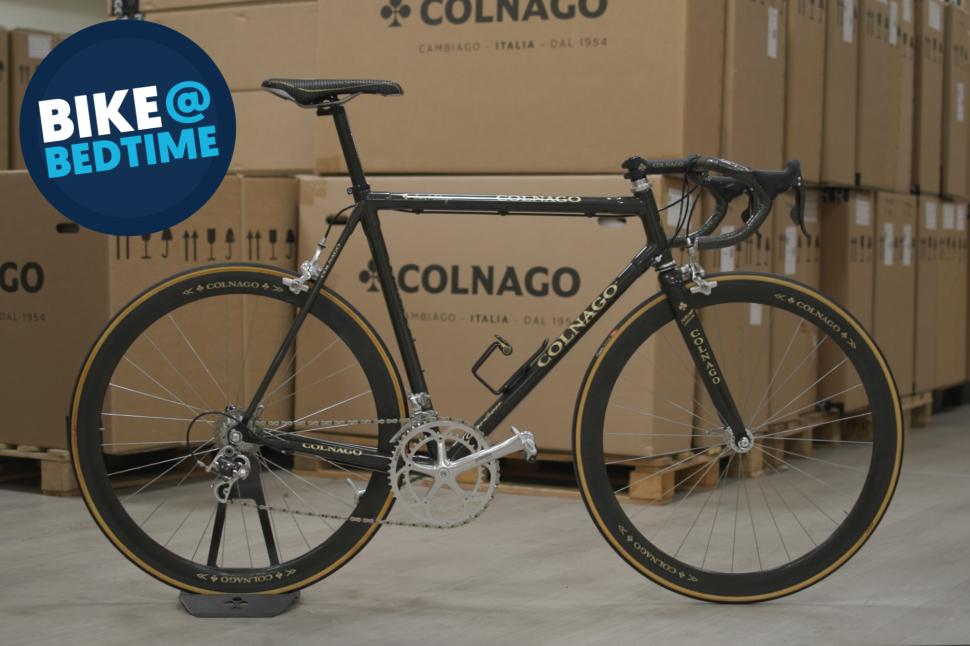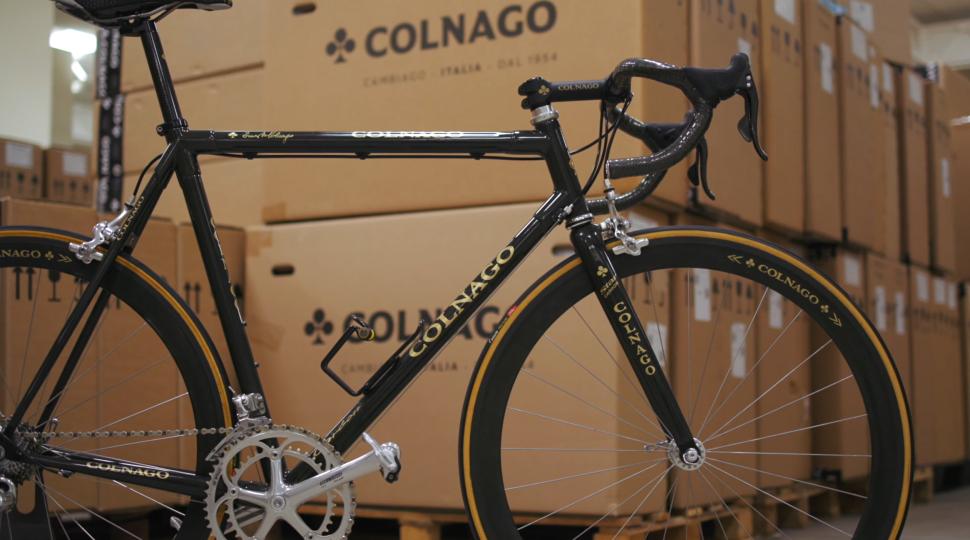- News
- Reviews
- Bikes
- Accessories
- Accessories - misc
- Computer mounts
- Bags
- Bar ends
- Bike bags & cases
- Bottle cages
- Bottles
- Cameras
- Car racks
- Child seats
- Computers
- Glasses
- GPS units
- Helmets
- Lights - front
- Lights - rear
- Lights - sets
- Locks
- Mirrors
- Mudguards
- Racks
- Pumps & CO2 inflators
- Puncture kits
- Reflectives
- Smart watches
- Stands and racks
- Trailers
- Clothing
- Components
- Bar tape & grips
- Bottom brackets
- Brake & gear cables
- Brake & STI levers
- Brake pads & spares
- Brakes
- Cassettes & freewheels
- Chains
- Chainsets & chainrings
- Derailleurs - front
- Derailleurs - rear
- Forks
- Gear levers & shifters
- Groupsets
- Handlebars & extensions
- Headsets
- Hubs
- Inner tubes
- Pedals
- Quick releases & skewers
- Saddles
- Seatposts
- Stems
- Wheels
- Tyres
- Health, fitness and nutrition
- Tools and workshop
- Miscellaneous
- Cross country mountain bikes
- Tubeless valves
- Buyers Guides
- Features
- Forum
- Recommends
- Podcast
feature
 Colnago C40 - 1 (1) (1)
Colnago C40 - 1 (1) (1)Check out the Colnago C40 Gold Limited Edition
The Colnago C40 was a ground-breaker when it was launched in 1994, showing that carbon was a great material for bikes raced at the highest level – even in the toughest of conditions. It became the first carbon bike ridden to victory at Paris-Roubaix the following year, and was the model the Mapei team used to secure all three places on the podium in 1996. This C40 Gold – which we saw when visiting Colnago recently – is one of a limited series of just 400 that was produced in 2000.
Carbon-fibre bikes have been ridden to every major race victory for years, but things were different back in the 1990s. Colnago had made several carbon bikes before the C40, but the material had yet to take over fully, and many people doubted its suitability for tough races like Paris-Roubaix. That all changed when Mapei’s Franco Ballerini won over the cobbles in 1995. In fact, the C40 was ridden to five Paris-Roubaix victories in six years.
Rather than being a monocoque produced in a mould, the C40 – C for ‘carbon’, 40 to denote Colnago’s 40th year in business – was made with tubes bonded into lugs. Most carbon-fibre bikes produced these days are monocoques, but Colnago still uses a lugged construction on its C68 road and gravel bikes.
Colnago made lugs of various angles and used different lengths of tubing to produce bikes in a huge number of frame sizes. Metal parts were still used for parts like the dropouts and the threaded sleeve for the bottom bracket, but the lugs and tubes were carbon fibre and Colnago claimed a frame weight of 1kg (size 54cm). There are far lighter bikes out there these days, of course, but the C40 was lower than anything else out there at the time.
Company chief Ernesto Colnago is quoted as saying, “When we built the C40 we were the only ones to build carbon frames and all the mechanics and competitor technicians were saying that they would be too dangerous to use on cobbled roads, especially with the straight carbon forks. There was a company that wanted to fit suspension forks on the bicycle, but I wasn't going to have suspension forks on the C40.
“The night before Paris- Roubaix I had Mr Squinzi, the Mapei boss, on the phone to me raising his concerns about using such a delicate-looking thing. I told him that we’d done all of the tests that we could on the frame and the fork and we were certain there would be no problem. I had to take personal responsibility for what was going to happen and I spent all night worrying about it, barely able to sleep. But when I heard that there were four Mapei riders in the break, I knew I could relax.”
Naturally, no one is saying that Mapei riders won because of the Colnago C40 – we can all agree that there were a helluva lot of other factors influencing race results in the 1990s – but it was a key bike in the rise of carbon fibre, both in the pro peloton and beyond.
> Why wider tyres on road bikes are here to stay… and why they may get wider still
In common with other bikes of the era, the C40 featured rim brakes, mechanical shifting, and external cable routing, and in 2000 Colnago released the C40 Gold pictured here, in a limited series of 400.
Its decals and head badge were gold, while the bike was built up with a Campagnolo Record 10-speed groupset, 45mm-deep carbon wheels, a handlebar and stem from ITM, and a San Marco Gold saddle. Oh, and those Vittoria tubular tyres: they’re just 19mm wide. Ouch!
Mat has been in cycling media since 1996, on titles including BikeRadar, Total Bike, Total Mountain Bike, What Mountain Bike and Mountain Biking UK, and he has been editor of 220 Triathlon and Cycling Plus. Mat has been road.cc technical editor for over a decade, testing bikes, fettling the latest kit, and trying out the most up-to-the-minute clothing. He has won his category in Ironman UK 70.3 and finished on the podium in both marathons he has run. Mat is a Cambridge graduate who did a post-grad in magazine journalism, and he is a winner of the Cycling Media Award for Specialist Online Writer. Now over 50, he's riding road and gravel bikes most days for fun and fitness rather than training for competitions.
Latest Comments
- JeremyD 12 sec ago
I picked up a Women's frameset heavily discounted during lockdown to build a gravel for my sister. At the time finding a wheelset that could both...
- belugabob 1 hour 22 min ago
What's strange, about the anti-LTN movement, is that just about any relatively modern housing development is a defacto LTN (and usually without any...
- Rendel Harris 2 hours 4 min ago
Is that great work cynical though, or just realistic? As George Bernard Shaw said, the ability to see things clearly is often labelled cynicism by...
- espressodan 2 hours 15 min ago
I don't mind paying for it. But I'm not paying £31 for it. ...
- 🐸 7 hours 11 min ago
No it can't. With lower gears to achieve the same speed you should change more gears and make more pedal strokes. It's just not comfortable. On...
- David9694 9 hours 51 min ago
Police, firefighters and paramedics at Staffordshire smash as 4x4 left in ditch...
- David9694 9 hours 54 min ago
Jolly Farmers pub in Forncett Saint Mary closed after crash...
- dodgy 11 hours 25 min ago
Hard to reconcile the asking price of this, with this https://road.cc/content/tech-news/quintana-roo-unveils-new-all-speed-aer...
- Secret_squirrel 11 hours 29 min ago
I've used Armourtex in north london if you're willing to Powdercoat. Great job. https://www.facebook.com/armourtex
- chrisonabike 12 hours 33 min ago
Well, on one of my uprights I have a mirror mounted but it is really too small / fitting is not secure enough. I find I just don't use it. On...





Add new comment
5 comments
“When we built the C40 we were the only ones to build carbon frames" apart from Look, Time and Vitus/Alan. Even Trek and Specialized were building carbon frames late 90s.
And the C40 is not a 1kg frame weight, more like 1.4-1.5kg.
Don't get me wrong, it's a lovely bike, but it seems after a couple of decades peoples memories aren't accurate.
Did the frames made by the other manufacturers you mention have carbon lugs? In 1994?
The Look KG 196 (1990 onwards) was a carbon monocoque frame and I think Vitus and Peugeot both had monocoque carbon frames on the market by '94.
The KG 196 was certainly ahead of its time. At first glance you could think it was a modern bike.
My Dad reached deep into His pockets to buy me a discounted Mapei coloured C40 frameset for the 1997 season. I set it up with a wild mix of Ultegra and Dura Ace Components and a borrowed C- Record crankset. I rode it Jalabert-style with a downtube shifter for the front derailleur and STI for the rear. I LOVED THIS THING! However in one of the first races that year some ignorant freak decided to ignore the race marshalls orders and drove his car onto the race course and into the front group I was leading at that moment. The full frontal impact bent the steel fork all the way back almost parallel to the down tube causing the front wheel to shave of the right shifter mount. Otherweise the frame stayed completely intact and the subsequent carbon fork upgrade made it one of my all time favourite bikes.
It was not meant to last though as in next spring the seat tube succumbed to the impact of my fat a®$€ when I hit a huge pothole while drafting my team car at 60km/h.
Ah the memories... thanks for the article!